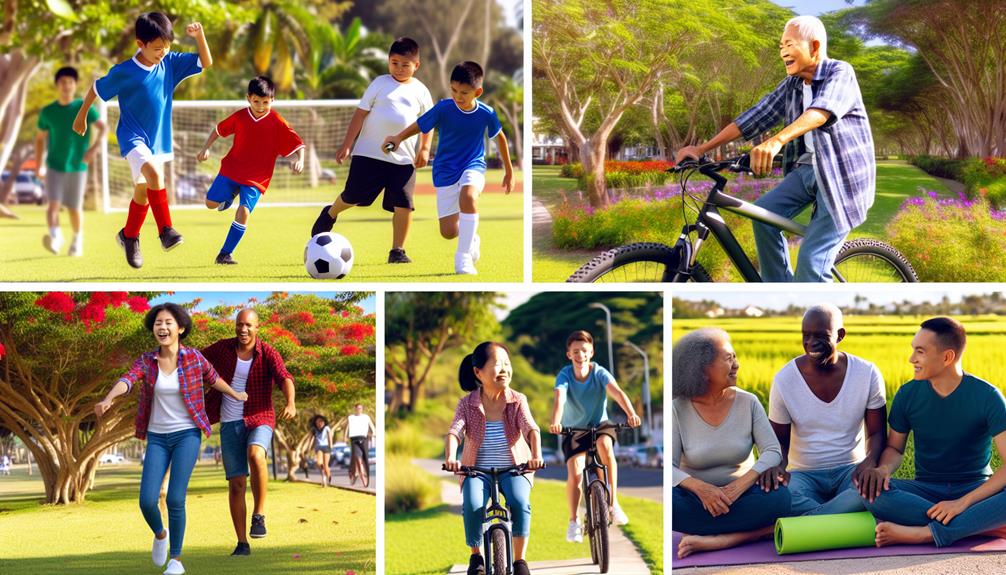Exercise needs vary by age, ensuring ideal health and well-being. Children and teens require at least 60 minutes of moderate to vigorous physical activity daily, which fosters fitness and social skills. Active adults should aim for 150 minutes of moderate-intensity exercise weekly, complemented by strength training twice a week. Older adults should focus on balance, flexibility, and strength to prevent falls and maintain muscle mass. Regular activity benefits mental health and social interaction for all ages. Understanding these guidelines helps establish a balanced fitness routine. Explore further to uncover more about specific exercises suited for every age group.
Key Takeaways
- Children and teens need 60 minutes of moderate to vigorous exercise daily for physical and mental well-being.
- Active adults should aim for 150 minutes of moderate-intensity aerobic activity each week, along with strength training twice a week.
- Older adults should prioritize flexibility and balance exercises to prevent falls, alongside strength training for muscle maintenance.
- Incorporating a variety of exercises, such as aerobic, strength, and flexibility activities, enhances motivation and overall fitness.
- Regular exercise promotes mental health, social interaction, and physical health, contributing to better cognitive function and weight management.
Guidelines for Children

Recognizing the critical role of physical activity in childhood development, health organizations recommend that children aged 6 to 17 engage in at least 60 minutes of moderate to vigorous exercise each day. This guideline emphasizes the importance of active play, which not only fosters physical fitness but also nurtures social skills, teamwork, and emotional well-being. Additionally, encouraging children to stay active can be supported by exploring various opportunities like discovering remote work options, which can offer parents flexibility in their schedules to promote family activities.
Encouraging children to participate in diverse activities—such as running, swimming, or team sports—can make exercise enjoyable and engaging. Additionally, limiting screen time is essential for promoting an active lifestyle. Excessive screen exposure often leads to sedentary behavior, which can impede physical development and contribute to health issues.
Parents and caregivers play a crucial role in establishing a balanced routine that incorporates both active play and limited screen time. Creating opportunities for outdoor activities, family sports, or dance can help children develop a lifelong appreciation for physical activity. By fostering an environment that prioritizes movement and connection with peers, families can cultivate a sense of belonging while ensuring children meet their exercise needs. Ultimately, these practices will contribute to healthier, happier, and more resilient individuals as they grow.
Recommendations for Teens
Teens are encouraged to engage in at least 60 minutes of moderate to vigorous physical activity each day to support their physical and mental well-being. Regular exercise during these formative years not only fosters healthy growth but also enhances mood, improves concentration, and builds social connections. Participating in physical activities can also improve academic performance, similar to how Unlocking Academic Success can aid with test preparation. Understanding the recommended activity levels and the myriad benefits of staying active is essential for fostering a lifelong commitment to health.
Recommended Activity Levels
Adolescents should aim for at least 60 minutes of moderate to vigorous physical activity each day to support their health and development. This duration is vital not only for physical fitness but also for mental well-being. Engaging in activities of varying exercise intensity can make workouts more enjoyable and effective. For example, teens might alternate between brisk walking, cycling, or playing sports, which allows them to experience different intensities and keep boredom at bay.
Incorporating a variety of activities is essential for overall fitness and can help build social connections. Team sports, dance classes, or group fitness sessions provide opportunities to bond with peers while staying active. It's important for adolescents to find activities they genuinely enjoy, as this fosters a sense of belonging and encourages lifelong habits.
Additionally, aiming for a mix of aerobic, muscle-strengthening, and flexibility exercises will guarantee a well-rounded fitness routine. By embracing diverse activities, teens can discover their interests, develop new skills, and enhance their physical health in a supportive environment. Prioritizing activity variety not only promotes fitness but also cultivates friendships, making exercise an integral and enjoyable part of their daily lives.
Benefits of Regular Exercise
Engaging in regular exercise offers numerous benefits that extend beyond physical health, greatly impacting mental and emotional well-being. For teens, maintaining an active lifestyle is essential, as it fosters social interaction and promotes a sense of belonging within peer groups. Exercise is also linked to improved mental health, providing important stress relief, enhancing mood, and boosting cognitive function.
Furthermore, regular physical activity plays a significant role in weight management and supports heart health, ensuring that the body functions effectively. Quality sleep, which can often be elusive during adolescence, is improved through consistent exercise, contributing to overall well-being.
Here's a simple breakdown of the key benefits of regular exercise for teens:
| Benefit | Description |
|---|---|
| Mental Health | Reduces anxiety and depression, enhancing mood. |
| Social Interaction | Encourages teamwork and builds friendships. |
| Longevity Benefits | Promotes long-term health and immune support. |
Incorporating these elements into daily routines not only cultivates a healthier lifestyle but also lays the groundwork for lifelong habits, ensuring that teens can thrive both physically and emotionally.
Active Adults' Needs

Active adults have unique exercise requirements that play an important role in maintaining overall health. Regular physical activity is essential for preventing chronic diseases and promoting mental well-being, making it critical to stay informed about local resources and support, such as those offered at Syracuse Community Health Center for extensive healthcare services. It is necessary to understand the recommended weekly activity levels, which typically include a combination of cardiovascular and strength training exercises. Balancing these components not only enhances physical fitness but also supports long-term well-being and vitality.
Recommended Weekly Activity
To maintain ideal health and well-being, adults should endeavor to meet specific exercise guidelines set forth by health organizations. The general recommendation for active adults is to engage in at least 150 minutes of moderate-intensity aerobic activity each week. This exercise duration can be broken down into manageable sessions, such as 30 minutes on most days, making it easier to integrate into busy schedules.
In addition to aerobic activities, incorporating a variety of exercises is essential for overall fitness and enjoyment. Activities such as walking, cycling, swimming, or dancing not only enhance cardiovascular health but also keep workouts interesting. Balancing different types of workouts can lead to improved motivation and adherence, fostering a sense of community among those who share similar fitness goals.
Furthermore, including strength training exercises at least twice a week complements aerobic workouts, promoting muscle health and functional strength. By adhering to these recommendations, active adults can create a well-rounded fitness routine that supports their physical and mental well-being, ultimately enhancing their quality of life and encouraging social connections through shared activities.
Balancing Strength and Cardio
Achieving a well-rounded fitness routine requires a thoughtful balance between strength training and cardiovascular exercises. This blend is essential for active adults aiming to enhance overall health, increase energy levels, and improve functional fitness. By incorporating both components, you can enjoy a multitude of benefits, including increased strength, improved cardiovascular endurance, and enhanced metabolic health.
To create an effective fitness regime, consider the following key elements:
- Frequency: Aim for at least two days of strength training per week, combined with 150 minutes of moderate-intensity cardio.
- Variety: Include different forms of strength training, such as free weights, resistance bands, and bodyweight exercises, alongside various cardio activities like cycling, swimming, or brisk walking.
- Intensity: Gradually increase the intensity of both strength and cardio workouts to continuously challenge your body and stimulate progress.
- Recovery: Allow adequate recovery time between strength sessions to prevent injury and promote muscle growth.
- Enjoyment: Choose activities that you enjoy to foster consistency and a sense of community in your fitness journey.
Exercise for Older Adults
As individuals age, maintaining physical fitness becomes essential for enhancing overall well-being and quality of life. Exercise for older adults should incorporate joint health and mobility exercises to promote flexibility and balance, which are critical for fall prevention. Engaging in regular strength training not only helps maintain muscle mass but also supports bone density, thereby reducing injury risk. For example, Bruce Willis has emphasized the importance of staying active as he navigates his own health journey, illustrating how exercise can play a key role in maintaining vitality and well-being Bruce Willis' health journey.
Personalized programs tailored to individual capabilities can make exercise more enjoyable and effective. These programs can include a mix of aerobic activities, strength training, and flexibility exercises, guaranteeing a thorough approach to fitness. Additionally, incorporating social engagement into exercise routines, such as group classes or walking clubs, fosters a sense of community, making physical activity a more fulfilling experience.
Moreover, exercise considerably contributes to mental wellness, alleviating symptoms of anxiety and depression commonly experienced in older adults. Emphasizing safe practices is paramount; older adults should consult healthcare professionals before starting any new exercise regimen to confirm it aligns with their health status. By prioritizing these aspects, older adults can enjoy a more active, healthier lifestyle, ultimately enriching their quality of life.
Benefits of Regular Activity

Regular physical activity offers a multitude of benefits that extend beyond mere physical fitness, greatly enhancing both mental and emotional well-being. Engaging in regular exercise not only contributes to weight management and disease prevention but also fosters a sense of community and belonging. Just as Tesla's innovations in electric vehicle technology are reshaping the automotive landscape, incorporating regular exercise can transform your overall health and well-being a revolution in wellness. Individuals who prioritize activity often experience improved mental health and emotional resilience.
The key benefits of regular activity include:
- Enhanced mood: Exercise releases endorphins, leading to feelings of happiness and reduced anxiety.
- Stress relief: Physical activity serves as a powerful outlet for alleviating daily stresses.
- Improved sleep: Consistent exercise can help regulate sleep patterns, promoting restorative rest.
- Cognitive function: Regular activity has been linked to improved memory and concentration, keeping the mind sharp.
- Social interaction: Participating in group exercises or sports cultivates friendships and a supportive network.
Incorporating regular exercise into daily life not only bolsters physical health but also greatly enriches mental clarity and emotional stability, creating a fulfilling lifestyle that embraces connection and well-being.
Types of Exercise to Consider
A diverse range of exercise types exists to cater to various fitness levels, preferences, and goals. Aerobic exercises, such as jogging, swimming, or cycling, are excellent for improving cardiovascular health and endurance. Strength training, which includes weight lifting and resistance exercises, builds muscle mass and enhances metabolic function. Flexibility routines, like yoga and stretching, promote joint health and improve overall mobility.
For those seeking social interaction, group exercises provide a sense of community and motivation. Options like Zumba or spin classes can make workouts enjoyable and engaging. Alternatively, individual sports, such as tennis or running, allow for personal pacing and goal setting.
If you prefer lower impact options, consider activities like walking, Pilates, or water aerobics, which are gentler on the joints while still promoting fitness. High-intensity workouts, including HIIT (High-Intensity Interval Training), deliver efficient results in shorter time frames, perfect for busy schedules.
Tips to Stay Motivated

Maintaining motivation in your exercise routine can often be the key to achieving long-term fitness goals. To sustain enthusiasm and commitment, consider integrating various strategies into your daily life. The right mix of camaraderie, fun, and accountability can make a significant difference.
- Set clear goals: Establish attainable milestones to measure your progress and keep you focused.
- Find workout buddies: Exercising with friends fosters a sense of belonging and encouragement, making workouts enjoyable.
- Incorporate playful activities: Engage in outdoor adventures or join community events that turn exercise into a fun experience.
- Utilize daily reminders: Set alarms or calendar notifications to guarantee you prioritize your fitness routine as part of your self-care.
- Reward yourself: Celebrate achievements with personal rewards, which can reinforce positive behavior and maintain motivation.
Incorporating Exercise Into Daily Life
Incorporating exercise into daily life can be seamlessly achieved by making small, intentional changes to your routine. By integrating physical activity into various aspects of your day, you can foster a healthier lifestyle while enjoying the process. Here are some effective strategies to contemplate:
| Activity Type | Examples |
|---|---|
| Walking Routines | Daily walks during lunch breaks |
| Family Activities | Outdoor adventures like hiking |
| Workplace Workouts | Quick daily stretches or desk exercises |
| Active Hobbies | Dancing, gardening, or cycling |
Engaging in social sports or fitness challenges can create a sense of belonging, making exercise more enjoyable. Additionally, commuting options like biking or walking to work not only promote fitness but also contribute to environmental sustainability. Incorporating home exercises into your evening routine allows for flexibility and convenience. By prioritizing family activities that encourage movement, everyone can participate in fostering a healthy lifestyle together. Remember, the key to consistency lies in making exercise a natural part of your daily life, thereby transforming it into a rewarding and fulfilling experience.
Frequently Asked Questions
How Can I Gradually Increase My Exercise Intensity?
To gradually increase exercise intensity, implement the principle of progressive overload, which involves systematically raising the demands placed on your body. Start by incorporating intensity variation, such as increasing weight, duration, or speed. For instance, add an additional set or reduce rest time between exercises. Listen to your body and adjust accordingly, ensuring that the changes feel manageable and sustainable. This approach fosters a sense of achievement and belonging within your fitness journey.
What Should I Do if I Have a Chronic Condition?
If you have a chronic condition, it is essential to approach exercise with care. Focus on exercise modifications that accommodate your specific needs, ensuring that activities do not exacerbate chronic pain. Start with low-impact exercises, such as walking or swimming, and gradually increase intensity as tolerated. Consulting with a healthcare professional can provide personalized guidance, helping you develop a safe and effective exercise plan that fosters both well-being and a sense of community.
Are There Specific Exercises for Mental Health?
Engaging in specific exercises can greatly enhance mental health. Mindful movement practices, such as yoga and tai chi, promote relaxation and self-awareness, reducing stress and anxiety. Additionally, aerobic activities like walking, running, or cycling stimulate the release of endorphins, improving mood and overall emotional well-being. Incorporating these forms of exercise into your routine fosters a sense of belonging, as they can be enjoyed individually or in community settings, enhancing social connections and support.
How Do I Choose the Right Type of Exercise?
Choosing the right type of exercise involves considering your exercise preferences and fitness goals. Begin by reflecting on activities that you enjoy, as this will enhance motivation and commitment. Assess your fitness objectives—whether they include weight loss, muscle building, or improving cardiovascular health—and select exercises that align with these aims. Additionally, consider your physical capabilities and any limitations. Ultimately, engaging in enjoyable and purposeful activities fosters a sustainable exercise routine and promotes overall well-being.
What Are the Best Times of Day to Exercise?
Determining the best times of day to exercise can enhance your workout experience. Morning workouts can invigorate your body and mind, promoting a productive day ahead. Conversely, evening routines may provide a way to unwind, allowing for stress relief after a busy day. Ultimately, the ideal time varies by individual preference, lifestyle, and energy levels. Emphasizing consistency is key, so choose a schedule that fosters belonging and supports your fitness journey.

